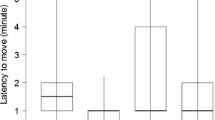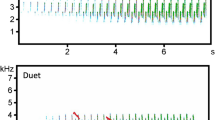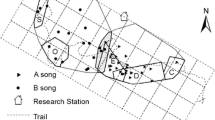Abstract
We studied duet song and vocal duetting behavior in an endemic Taiwanese passerine, Steere’s liocichla (Liocichla steerii). We found that the leading male song in duets was highly individualistic. Also, we found duetting behavior varied significantly across different habitat types. Females were more likely to answer male songs in densely vegetated, steep forest habitat compared to open agricultural habitat. These findings provide quantitative evidence for vocal individuality for a duet song and provide tentative support for the idea that females are duetting to reveal their location to their mates.


Similar content being viewed by others
References
Bard SC, Hau M, Wikelski M, Wingfield JC (2002) Vocal distinctiveness and response to conspecific playback in the spotted antbird, a neotropical suboscine. Condor 104:387–394
Charif RA, Mitchell S, Clark CW (1995) Canary 1.2 user’s manual. Cornell Laboratory of Ornithology, Ithaca, NY
Dilger WC (1953) Dueting in the crimson-breasted barbet. Condor 55:220–221
Farabaugh SM (1982) The ecological and social significance of dueting. In: Kroodsma DE, Miller EH (eds) Acoustic communication in birds, vol 2. Academic, New York, pp 85–124
Grimes L (1966) Antiphonal singing and call notes of Laniarius barbarus. Ibis 108:122–126
Hall ML (2004) A review of hypotheses for the functions of avian duetting. Behav Ecol Sociobiol 55:415–430
Hall ML, Magrath RD (2000) Duetting and mate-guarding in Australian Magpie-Larks (Grallina cyanoleuca). Behav Ecol Sociobiol 47:180–187
Langmore NE (1998) Functions of duet and solo songs of female birds. Trends Ecol Evol 13:136–140
Levin R (1996a) Song behaviour and reproductive strategies in a duetting wren, Thyothorus nigricapillus: I. Removal experiments. Anim Behav 52:1093–1106
Levin R (1996b) Song behaviour and reproductive strategies in a duetting wren, Thyothorus nigricapillus: II. Playback experiments. Anim Behav 52:1107–1117
Lo L-C (1987) The biological study of Liocichla steerii at Chitou area. MS dissertation, National Taiwan University (in Chinese)
Marzluf JM (1988) Vocal recognition of mates by breeding Pinyon Jays, Gymnorhinus cyanocephalus. Anim Behav 36:296–298
McGarigal K, Cushman S, Stafford S (2000) Multivariate statistics for wildlife and ecology research. Springer, Berlin Heidelberg New York
Morton ES (1996) A comparison of vocal behavior among tropical and temperate passerine birds. In: Kroodsma DE, Miller EH (eds) Ecology and evolution of acoustic communication in birds. Academic, New York, pp 258–268
Robertson BC (1996) Vocal mate recognition in a monogamous, flock-forming bird, the Silvereye, Zosterops lateralis. Anim Behav 51:303–311
Smith WJ (1994) Animal duets: forcing a mate to be attentive. J Theor Biol 166:221–223
Smith JI, Yu H-T (1992) The association between vocal characteristics and habitat type in Taiwanese passerines. Zool Sci 9:659–664
Sonnenschein E, Reyer H-U (1983) Mate guarding and other functions of antiphonal duets in the Slate-Coloured Boubou (Laniarius funebris). Zeitschrift fur Tierpsychologie 63:112–140
Stokes AW, Williams HW (1968) Antiphonal calling in quail. Auk 85:83
Stutchbury BJM, Morton ES (2001) Behavioral ecology of tropical birds. Academic, San Diego
Terry AMR, McGregor PK, Peake TM (2001) A comparison of some techniques used to assess vocal individuality. Bioacoustics 11:169–188
Thorpe WH (1972) Dueting and anitphonal singing in birds: Its extent and significance. Behaviour Supplement no. 18
Watson M (1969) Significance of antiphonal song in Eastern Whipbirds, Psophodes olivaceus. Behaviour 35:157–167
Wickler W (1980) Vocal duetting and the pair bond: I. Coyness and partner commitment. A hypothesis. Z Tierpsychol 52:201–209
Wickler W, Seibt U (1980) Vocal dueting and the pair bond: II. Unison dueting in the African Forest Weaver, Symplectes bicolor. Z Tierpsychol 52:217–226
Acknowledgements
Thanks to the staff of National Taiwan University’s Meifeng Highlands Experiment Farm and the Taiwan Forest Bureau. H. Yan allowed the use of recording equipment and P. Nolan and D. Mennill aided in the analysis. Also, thanks to W-T. Liang, Y-T. Liu, S-F. Shen, H-Y. Huang for help in the field. D. Westneat, G. Hill, D. Mennill, D. Logue and two anonymous reviewers provided valuable comments. Funding was provided by National Science Council and Endemic Species Research Institute in Taiwan, and National Science Foundation grant no. 0307421 and National Science Foundation’s East Asia and Pacific Summer Program in the USA.
Author information
Authors and Affiliations
Corresponding author
About this article
Cite this article
Mays, H.L., Yao, CT. & Yuan, HW. Antiphonal duetting in Steere’s liocichla (Liocichla steerii): male song individuality and correlation between habitat and duetting behavior. Ecol Res 21, 311–314 (2006). https://doi.org/10.1007/s11284-005-0115-0
Received:
Accepted:
Published:
Issue Date:
DOI: https://doi.org/10.1007/s11284-005-0115-0




